What if I told you that saying goodbye to the bedtime bottle could be a loving step forward for your little one? Many parents view this nightly ritual as irreplaceable—a sweet moment of connection. But as your child grows, their needs evolve, and so should their routines.
I remember holding my baby during those quiet nights, bottle in hand, thinking this phase would last forever. Pediatric experts agree: around 12-13 months, children no longer need milk or formula before sleep for nutrition. In fact, lingering too long with the bottle can impact dental health and sleep patterns.
Change feels daunting, but here’s the truth: this transition isn’t about loss. It’s about creating new rituals—like cozy storytime or soft lullabies—that comfort and bond. You’re not taking something away; you’re making space for growth.
Through trial and error (and plenty of patience), I discovered strategies that worked for my family. This guide blends practical tips from child development specialists with real-life stories to help you navigate this shift with confidence. Let’s turn uncertainty into celebration—one small step at a time.
Introduction to the Transition
Let me share a secret: those nightly feedings hold more power than you might realize. For countless families, the bedtime bottle isn’t just about nourishment—it’s a cherished ritual that signals safety and connection. But as your little one grows, this comforting routine needs gentle reshaping to support their development.
When Comfort Meets Routine
Many toddlers associate their bottle with drifting off to sleep. Pediatricians explain this isn’t just about hunger—it’s a sleep cue ingrained through repetition. Think about it: the warmth, the sucking motion, the quiet closeness. These elements create a powerful link between feeding and falling asleep.
Why Timing Matters
Shifting the bottle earlier in the evening—like offering it before bath time—helps separate feeding from sleep. One family I spoke with moved their child’s milk session 15 minutes earlier each night. Within a week, their toddler stopped expecting the bottle at lights-out. Small adjustments make big differences!
Here’s what experts emphasize:
- Consistency builds trust—stick to the new routine
- Dental health improves when milk isn’t pooling overnight
- Independent sleep skills grow when sleep props fade
Change can feel bittersweet, but remember: you’re not removing comfort. You’re teaching your child they can feel secure without the bottle. In the next sections, we’ll explore creative ways to build this confidence together.
Understanding the Role of Bedtime Bottles
Remember when those late-night feedings were all about nutrition? In the first year, every sip of milk delivered crucial calories for rapid growth. But as your child approaches 12 months, that familiar container starts serving a different purpose—one that’s more about emotional comfort than physical nourishment.

Nutritional Benefits vs. Sleep Prop
Pediatricians draw a clear line here: “Once solid foods provide 70-80% of daily calories, nighttime milk becomes optional”. By their first birthday, most children thrive on meals eaten during daylight hours. That bedtime drink? It’s often just a sleep-triggering ritual now.
| First 12 Months | 12+ Months | |
|---|---|---|
| Primary Purpose | Nutritional support | Sleep association |
| Milk Quantity | 4-8 oz needed | 1-3 oz typical |
| Health Impact | Supports growth | Risk of tooth decay |
I’ve watched toddlers clutch their bottles like lovies, taking only symbolic sips. One mom shared how her son would “forget to swallow” once he started drifting off. These patterns show the shift from feeding to soothing.
Dental experts stress that milk sitting on teeth overnight erodes enamel. There’s also the dinner dilemma—kids who fill up on milk may push away veggies and proteins. Yet we can’t dismiss the bottle’s past value. It nurtured your child through infancy. Now, it’s time to nurture new skills.
When to Begin Saying Goodbye
Let’s talk about timing—because every child dances to their own developmental rhythm. While experts suggest starting around 12-13 months, your little one’s unique growth patterns will guide you best. This phase often coincides with exciting changes like emerging teeth and growing independence.
Spotting Nature’s Green Lights
Your child’s body often signals readiness before their words can. Look for these milestones:
| Readiness Sign | What It Looks Like | Action Step |
|---|---|---|
| Solid Food Interest | Eating 3 meals + snacks daily | Offer milk in cups at meals |
| Self-Soothing Skills | Falling asleep without sucking | Introduce comfort objects |
| Dental Development | 4+ front teeth visible | Brush after last drink |
I’ve watched toddlers naturally lose interest in their nighttime drink as they master new skills. One mom told me her daughter started “turning her head away” when offered the familiar container—a clear biological cue.
Reading Your Child’s Cues
Beyond physical changes, emotional readiness matters. Does your little one still crave comfort from the container, or have they found other ways to unwind? Notice if they:
- Leave milk unfinished regularly
- Respond well to alternative routines
- Wake less frequently at night
Pediatrician Dr. Elena Torres notes: “The smoothest transitions happen when children lead the way—we’re just following their growth.” If setbacks occur, take heart! A skipped nap or new tooth might temporarily revive old habits. Stay consistent, and trust your child’s natural progress.
Effective Strategies for Weaning off Bedtime Bottle
Change often feels like climbing a mountain, but with the right path, every family can reach the summit. Let’s explore two proven methods to help your little one adapt while keeping their sleep quality intact.

Gradual Reduction Techniques
Think of this as dimming a light instead of flipping a switch. Start by offering 1 ounce less milk each night over 5-7 days. Many parents find success pairing this with a “last sip ceremony”—a special goodbye kiss for the container when it’s empty.
Sarah, a mom from Colorado, shared: “We called it ‘big kid sips’ and celebrated every ounce reduction with a sticker chart. By night 10, my daughter didn’t even ask!”
Transitioning the Timing
Move the milk session 15 minutes earlier in your evening routine every 2-3 days. Aim to serve it before bath time instead of at lights-out. This gentle shift helps break the feed-to-sleep connection.
| Method | Best For | Key Benefit |
|---|---|---|
| Gradual Reduction | Sensitive children | Minimizes resistance |
| Cold Turkey | Older toddlers | Quick resolution |
| Timing Shift | All ages | Preserves routine flow |
While some families choose the cold turkey approach for faster results, most pediatricians recommend gradual changes. Whichever path you take, maintain other comforting elements like storytime or back rubs. Consistency turns uncertainty into familiarity—one loving step at a time.
Transitioning from Bottle to Sippy Cup
Picture this: your child proudly gripping their first cup like a tiny explorer clutching a treasure. That’s the magic of finding the right drinking partner for this new phase. Moving to a sippy cup isn’t just about dental health—it’s a confidence-building milestone that sparks independence.
Finding the Perfect Match
Not all cups are created equal. Look for features that match your child’s skills:
- Soft spouts mimic bottle familiarity
- Weighted straws help younger kids sip easily
- Wide handles support wobbly grips
I’ve seen parents light up when their child masters a spill-proof cup. One dad shared how his son “drank water like a pro” after choosing a dinosaur-themed design. The right cup becomes a beloved tool, not just a replacement.
| Type | Best For | Transition Tip |
|---|---|---|
| 360° Edge | Advanced drinkers | Use during meals |
| Straw Cup | New learners | Start with thick smoothies |
| Open Cup | Supervised practice | Try at snack time |
Begin with daytime drinks when energy levels are high. Offer milk in the new cup after naps or during play. As skills grow, phase out the container entirely. Most kids adapt within 2-3 weeks—especially when they feel ownership over their “big kid” cup.
Remember: spills are progress markers! Each wobble teaches balance. With patience and the right tools, your child will toast to their growing skills—one sip at a time.
Handling Emotional Attachments and Sleep Associations
Change often starts with a cuddle, not a calendar. That familiar container isn’t just a feeding tool—it’s become your child’s emotional anchor. Like a well-loved stuffed animal, its presence signals safety. Recognizing this helps us replace its role with care.
Managing Comfort and Reassurance
One mom told me her toddler would “hold the empty container like a security blanket”. This is common. Start by introducing a new comfort object during daytime snuggles. Let your child pick a soft toy or blanket that feels special.
Try these swaps:
- Offer warm milk in a cup before brushing teeth
- Replace sucking motions with gentle back rubs
- Use a nightlight with their favorite color
Sleep training doesn’t mean withholding comfort. A gradual approach works best. Sit near their bed while they fall asleep without the familiar prop, moving farther each night. “It took three nights,” shares dad Mark. “Now she hugs her bunny instead.”
Developing Alternative Bedtime Rituals
Create new “connection points” that fill the emotional gap. A five-minute story session or quiet song can become the highlight of their routine. I’ve seen families bond over:
| Activity | Benefit | Parent Tip |
|---|---|---|
| Guided breathing | Teaches self-soothing | Say: “Let’s blow pretend bubbles” |
| Gratitude sharing | Builds positivity | Name three happy moments |
| Hand-holding | Offers physical reassurance | Use lotion for calming scents |
Consistency transforms uncertainty into trust. If tears come, validate feelings: “I know this feels different. We’ll figure it out together.” Within weeks, these new habits become their normal—proof that love adapts as they grow.
Expert Tips and Real-Life Parental Success Stories
Jessica’s hands shook as she hid the last container in her daughter’s closet. “We told her the Bottle Fairy needed them for new babies,” she shared. Within three nights, her toddler stopped asking—proof that creativity often wins over resistance.
Lessons Learned from Pediatric Insights
Dr. Amina Carter, a pediatric sleep specialist, explains: “Children adapt faster when parents frame changes as growth opportunities.” She emphasizes moving milk sessions to dinner time while introducing non-food comforts like stuffed animals or glow-in-the-dark stars.
Miguel from Texas found success through gradual shifts: “We served milk in cups during storytime, then brushed teeth together. Now she associates books with relaxation, not feedings.” His approach mirrors methods sleep consultants recommend:
| Strategy | Parent Tip | Outcome Timeline |
|---|---|---|
| Bottle Fairy Ceremony | Trade containers for small toys | 2-4 nights |
| Milk & Story Pairing | Use sippy cups during reading | 1 week |
| Positive Reinforcement | Celebrate dry nights with stickers | 3-5 nights |
Training little ones requires patience, but the rewards shine through. One mom described her son’s proud grin after his first sleep night without his former companion: “He kept saying ‘I big now!’ That confidence made every tough moment worth it.”
Remember: your journey might include setbacks or creative solutions. What matters is staying consistent while honoring your child’s emotional needs. As Jessica learned, “Progress isn’t perfect—it’s persistent.”
Building and Maintaining a Consistent Bedtime Routine
The magic happens when bath bubbles pop and story pages turn—this is where new sleep foundations form. Predictable patterns create security for toddlers, especially during transitions. A well-crafted evening sequence becomes their compass, guiding them toward restful nights.
Integrating Bath, Storytime, and Cuddles
Start with warm water play to signal winding down. One parent shared: “We add lavender drops and talk about our day—it’s our reset button.” Follow with a favorite book, letting your child choose the title. This hands-on decision builds ownership of the new routine.
Try this 25-minute sequence:
- Bath (8 minutes): Include pouring toys for sensory calm
- Pajamas + toothbrushing (5 minutes): Add a silly song
- Story (7 minutes): Use character voices for engagement
- Cuddle time (5 minutes): Discuss tomorrow’s adventures
Ensuring a Seamless Nighttime Transition
Consistency thrives on teamwork. Involve siblings in storytime or grandparents in goodnight calls. Pediatric sleep consultant Mara Lin advises: “When the whole family participates, children feel supported—not singled out.”
| Challenge | Solution | Result |
|---|---|---|
| Resisting bath | Offer color-changing bath tablets | Excitement replaces resistance |
| Delaying bedtime | Use visual timer showing routine steps | Clear expectations reduce stalling |
| Night waking | Place comfort items within reach | Self-soothing skills grow |
When tough nights happen—hello, time changes!—keep the sequence intact but shorten activities. A 3-minute story still works if read with extra snuggles. Remember: flexibility within structure teaches resilience.
Conclusion
Every parent wonders when their child will take that next big step—and here you are, guiding them through it. Eliminating the bedtime bottle isn’t just about preventing decay or improving sleep hygiene. It’s about nurturing your little one’s ability to fall asleep without props, building resilience that extends far beyond nighttime.
Through this journey, you’ve learned to spot readiness signs and create new rituals. Maybe you shifted milk sessions earlier or introduced a beloved sippy cup. Whatever path you chose, remember: consistency transforms uncertainty into trust. Those first tear-free nights or successful toothbrushing sessions? They’re victories worth celebrating.
I’ve seen families thrive by focusing on sleep independence rather than perfect routines. One mom shared how her toddler started requesting extra storytime snuggles instead of their former container. Another found that a post-bath family dance party became their new favorite wind-down activity.
Trust your instincts. If setbacks happen, revisit your routine with gentle adjustments. Pediatric experts agree: children adapt faster when changes feel like shared adventures. With each passing night, you’re building more than a new rhythm—you’re nurturing confidence that lasts a lifetime.
FAQ
How do I know if my child’s bottle is a sleep crutch?
If your little one relies on the bottle to fall asleep or struggles to stay asleep without it, it’s likely become a sleep association. Watch for patterns where they wake frequently seeking the bottle for comfort rather than hunger.
What age should we start phasing out bedtime feeds?
Most pediatricians recommend beginning the transition around 12-18 months, when nutritional needs shift and teeth development becomes a priority. Always consult your doctor to align with your child’s growth milestones.
Can cold turkey methods harm my toddler emotionally?
Abrupt changes can cause temporary stress, but many families succeed with gentle alternatives. Pair consistency with extra snuggles, soothing lullabies, or a favorite stuffed animal to provide comfort during the adjustment period.
How do I handle middle-of-the-night requests for milk?
Gradually reduce the amount offered each night while introducing other calming rituals. Try a small sip of water in a sippy cup paired with back rubs or whispered stories to ease the shift away from nighttime feeds.
Are certain cups better for transitioning from bottles?
Look for spill-proof, soft-spout designs that mimic bottle nipples initially. Brands like Munchkin’s Miracle Cup or NUK Learner Sippy work well. Transition to open cups or straw cups as motor skills develop.
Will dropping the bottle disrupt our bedtime routine?
Consistency is key! Replace bottle time with activities like warm baths, storybooks, or quiet songs. These create new positive associations while maintaining structure. Many parents find bedtime becomes smoother without bottle-related wake-ups.
How does prolonged bottle use affect dental health?
Frequent milk exposure overnight can lead to tooth decay. The American Academy of Pediatric Dentistry advises finishing feeds 30 minutes before brushing to protect emerging teeth while supporting oral hygiene habits.




